Acer’s 21-inch curved laptop behemoth is $9,000 – CNET
If you hate the idea of this massive 21-inch curved screen
gaming
laptop, you’re not going to buy it.
Mục Lục
The Good
The 21-inch curved display feels very immersive in games. There are a ton of fun features and extras, including a reversible touch/number pad, eye tracking cameras and swappable WASD keys. The mechanical keyboard is excellent for gaming.
The Bad
Even these high-end components don’t fully justify the price. The display has a lower resolution than we’d like, battery life is poor and moving the touchpad away from its traditional spot is never a good idea.
The Bottom Line
The limited edition Acer Predator 21 X is equal parts Insanely powerful and crazy cool — you just need a lottery win or random inheritance to afford it.
If you love the idea of this massive 21-inch curved screen gaming laptop, you’re still not going to buy it — because it costs as much as a used car.
But just in case you are one of the very, very small handful of people committed to laying down some major cash for the limited edition Acer Predator 21 X, then nothing I say in this review is going to change your mind one way or the other.

If you are willing to spend a lot of money for a gaming laptop (and we mean A LOT), then get this.
And when I say “major cash,” I don’t mean the $2,000 or $3,000 you might be expecting for a high-end gaming laptop. The single configuration offered by Acer is a heart-attack-inducing $8,999 in the US (although Acer’s website lists it as “coming soon”). Acer is offering the 21 X in Europe as well for even more: €9,999, which translates to £8,372, or about $10,700. It’s not listed on Acer’s Australian website, but the price translates to about AU$14,220.
So, yeah, this is probably out of your price range unless you think it’s worth a kidney on the black market. Still, you’re probably intensely curious, as I was, about just how Acer managed to pack so much high-end hardware into a single laptop, and how even dual video cards and a unique 21-inch curved display could justify the headline-grabbing price. It’s a bit like getting a detailed walkthrough of a concept car you’ll never own — it’s cool to see it put through its paces, and some of the ideas inside may eventually trickle down to more realistically priced products.
Acer Predator 21 X
Price as reviewed $8,999 Display size/resolution 21-inch, 2,560×1,080 displayPC CPU 2.9GHz Intel Core i7-7820HK (OC)PC Memory 64GB DDR4 SDRAM 2,400MHzGraphics (2) 8GB Nvidia GeForce GTX 1080 (OC)Storage (2) 512GB SSD RAID 0 + 1TB HDDNetworking 802.11ac wireless, Bluetooth 4.1Operating system Microsoft Windows 10 Home (64-bit)
Throwing the laptop world a curve ball
The curved screen is the single-biggest talking point about the 21 X, as this is the first laptop to offer one. It’s even a deeper curve than on big-screen curved
TVs
. The curve is measured in “R,” which reflects the radius if it were to be extended into a full circle. The lower the R, the deeper the curve. TVs have a 4,000R or so curve, while the 21 X is 2,000R — which means it’s curvier.
But considering the small size of the screen, even when compared to curved big-screen TVs the effect is modest. I can see making the case for improved immersion, but it’s neither a deal-maker or a deal-killer. There’s a small amount of wraparound effect, especially in games as well as when you’re sitting close to the screen, but while surfing the web or viewing video, I didn’t find the curve distracting.
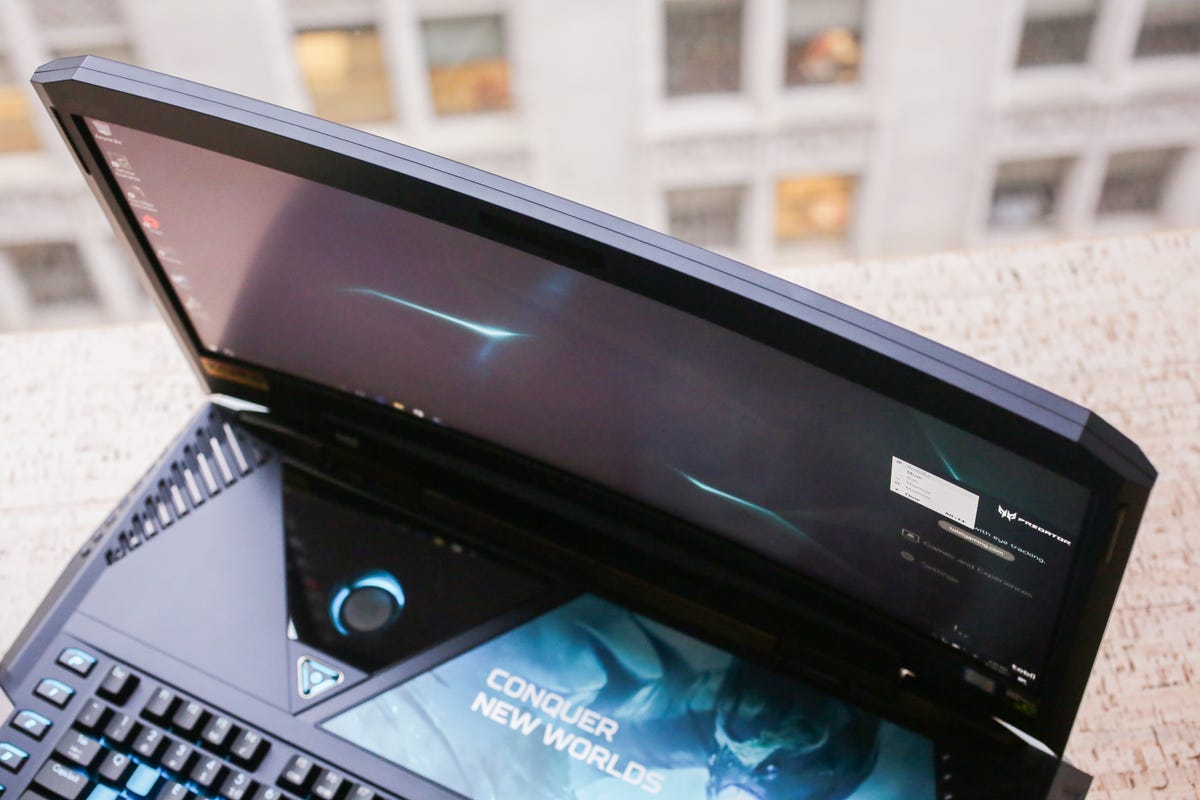
The curved screen is a big focus of the laptop.
While the diagonal measurement pegs this as a 21-inch display, that’s because it’s extra wide. The screen is as tall as the display on a standard 17-inch gaming laptop, just extended out to the sides. For a different take on a similar concept, check out the three-screen gaming laptop prototype from Razer, called Project Valerie. There, it’s a single 17-inch display that adds two additional pull-out displays for a wider view.
However, the screen itself is a bit of a letdown in some ways. On the plus side, it’s very matte, with basically zero screen glare (the curve helps with that), but it’s also smaller than you might expect given the dimensions, and has just a modest 1,080 pixels of vertical resolution. It’s also dimmer than I’d like, with less of the colorful pop seen in the best gaming laptop displays.
That bigly bod
What’s a laptop with a 21-inch display and dual graphics cards like? It’s huge, as one might expect. But also not as overpowering as you might fear. It’s more like having a squat all-in-one gaming desktop, and only slightly more mobile. It’s 18.5 pounds (or 26 pounds if you include the two big power bricks) and your purchase price includes a huge rolling suitcase, complete with foam cutouts for the system and its accessories.
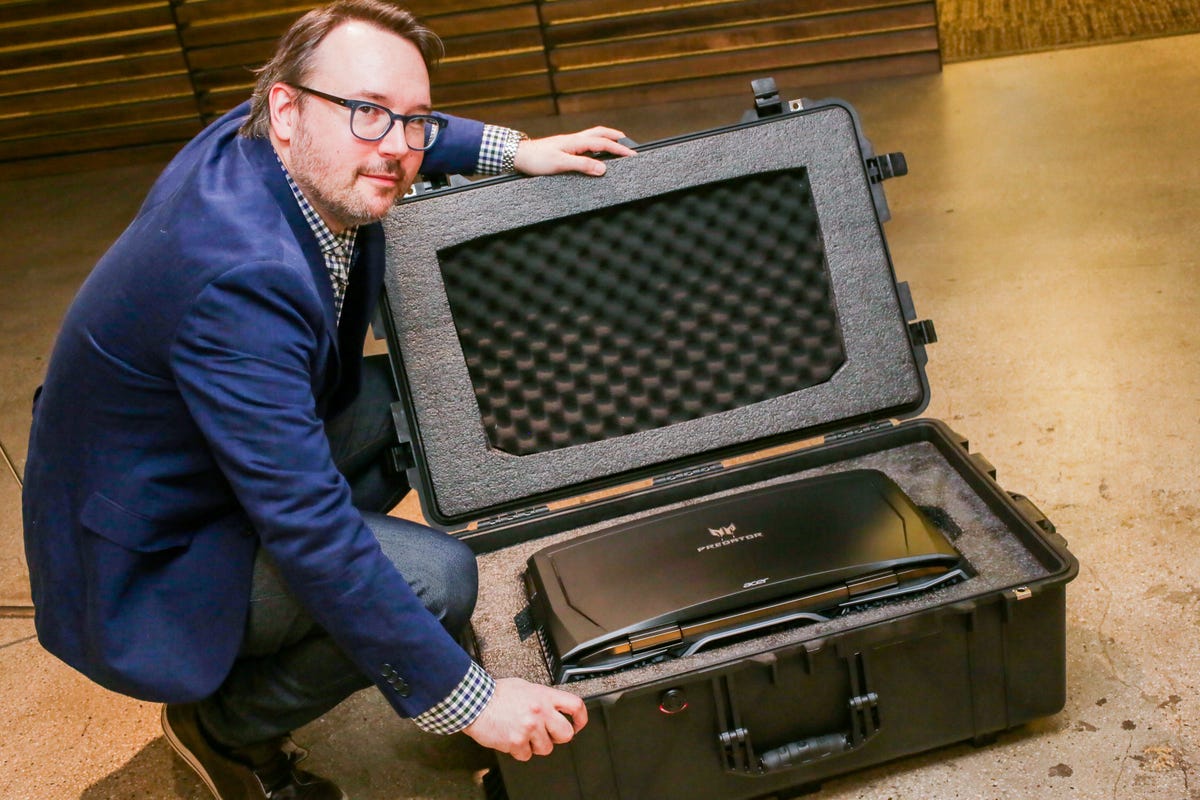
This expensive machine at least comes with an impressive case.
Interestingly, this isn’t the first super-massive gaming laptop we’ve seen, not even recently. There’s a real similarity to the MSI GT83VR, which we referred to as a “suitcase nuke” of a laptop, thanks to its retro-looking raised keyboard and imposing clamshell shape. Like the MSI, the Acer 21 X has plenty of room for ports, including four USB 3.0 ports, one USB-C, two DisplayPort outputs and one HDMI output.
The 21 X is not only wide, it’s tall — the mechanical keyboard rises up more than two inches from the desk (and with the lid closed, the entire system is about four inches thick in the back). That’s why I love the add-on wrist support. It’s a slightly padded plastic form that snaps right onto the front lip of the laptop via built-in magnets. Because the keyboard and keyboard tray are so high up off the desk, the wrist support makes for more comfortable typing, at least for me. If the angle you’re working or playing at doesn’t require extra support, just pop it off and set it aside.
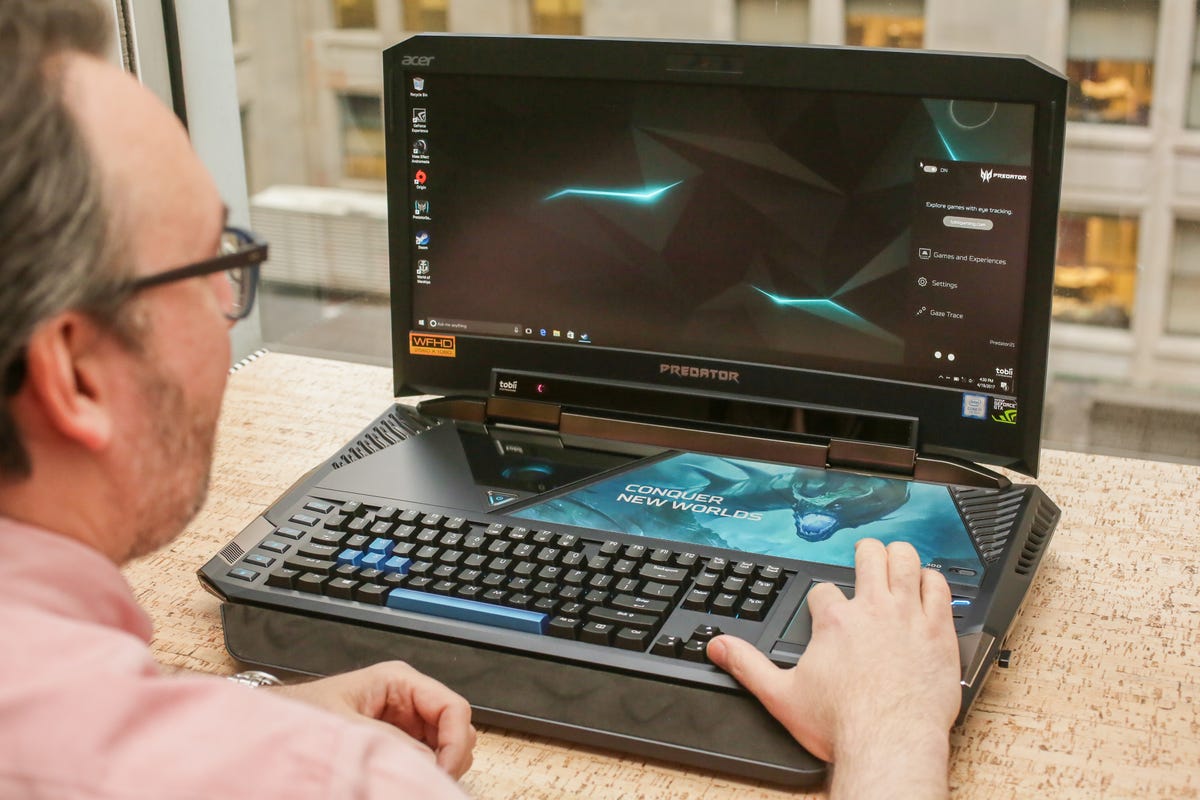
The wrist support makes for a more comfortable typing experience.
Now, let’s talk about that touchpad. Why do gaming
laptops
with ambitious, high-end designs feel the need to re-orient the familiar touchpad? We’ve seen it on the MSI GT83VR, we’ve seen it on the Razer Blade Pro and now we’re seeing it on the Acer Predator 21 X. In all three cases, the touchpad moves from its familiar under-the-keyboard location to a spot on the right side of the chassis.
By doing this, you’re messing with decades of muscle memory, and it makes using the pad much less intuitive than it should be. That said, two things keep this from being a bigger issue. The touchpad itself was surprisingly responsive, which is not always a given in a big gaming laptop. Even two-finger scrolling felt very accurate and natural. Also, for games you’ll be using either an external mouse or a gamepad almost exclusively, so this may not be the most heavily used touchpad in laptop history.

In a break from tradition, the touchpad is placed to the right of the keyboard and flips over to reveal a number pad.
There’s also an interesting hidden feature on the touchpad. It detaches, pulling up and out from its spot on the keyboard tray, and flips over to reveal a 10-key number pad. You can even hot-swap between sides while the system is running.
There’s a giant dragon on it
Forget about putting a bird on it. Acer has slapped a giant illustration of a dragon on the front of the Predator 21 X. It’s got a bit of that Dungeons & Dragons, Frank Frazetta vibe, and the blue tint matches the blue keyboard backlight and blue power button, as well as the backlit blue fan sitting under a transparent plastic panel above the keyboard.
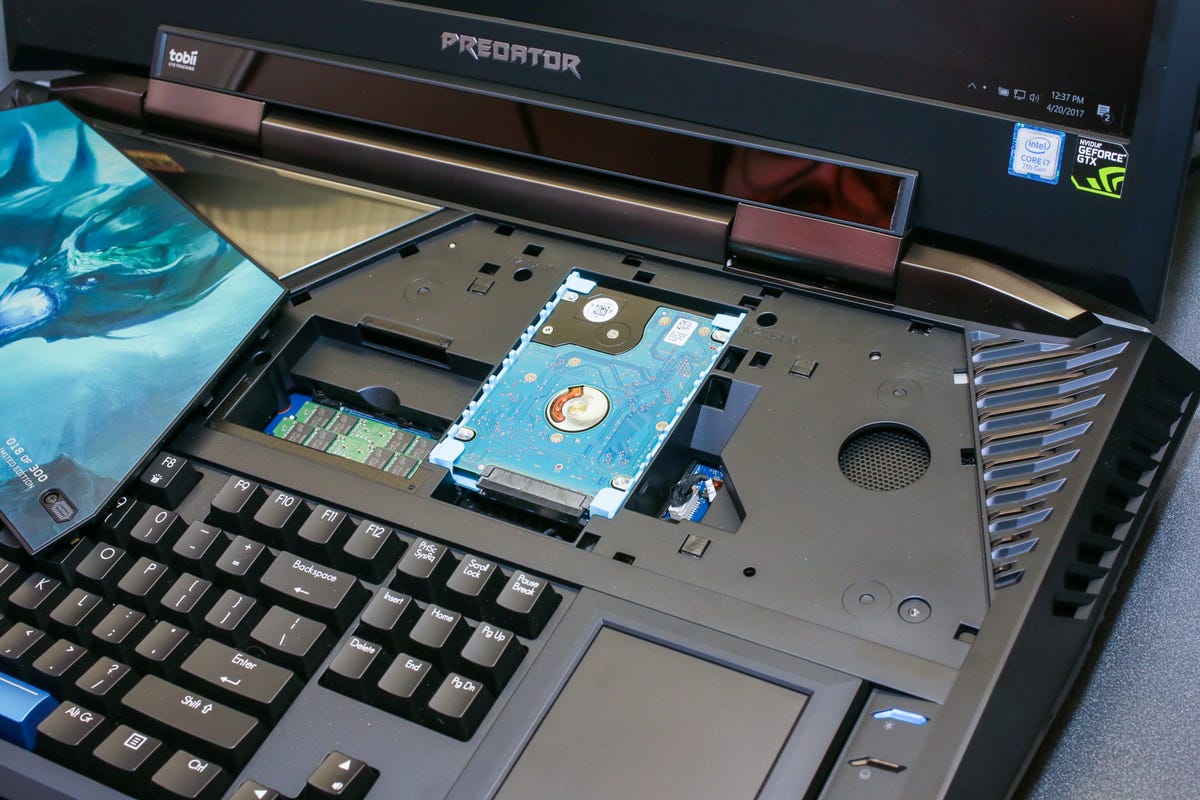
Remove the dragon panel and you will find the hard drive.
The dragon panel unscrews to reveal a storage bay, but with 2TB of total storage, you’re probably pretty set in that department for a while.
At nine grand a pop, Acer clearly doesn’t think they’ll sell all that many of these, as our review loaner was labeled as #18 out of 300 (which would still bring in a total of $2.7 million if each one sold at the full retail price). Still, the response from everyone who saw the 21 X was the same: “What if I don’t want a giant blue dragon on my $9,000 laptop?” (Update: Acer tells me the panel is indeed swappable, so it’s not dragon-only.)
The widescreen world of gaming
For games, the big question mark is: Does the game I want to play easily support a wider 21:9 aspect ratio? Today, many PC games do, although that wasn’t always the case, even as recently as a year or two ago. But, even some new games handle it better than others.
For example, Mass Effect: Andromeda is about as big-budget and mainstream as a game is going to get. Most of the actual gameplay worked fine in 21:9, and the in-game settings options recognized the 2,560 by 1,080-pixel native resolution of the display. But, cutscenes and some menu or loading screens defaulted to 16:9, with black bars at either side. The latest Call of Duty game behaved similarly, with basic gameplay in 21:9, but some in-game map screens were distorted and hard to use.
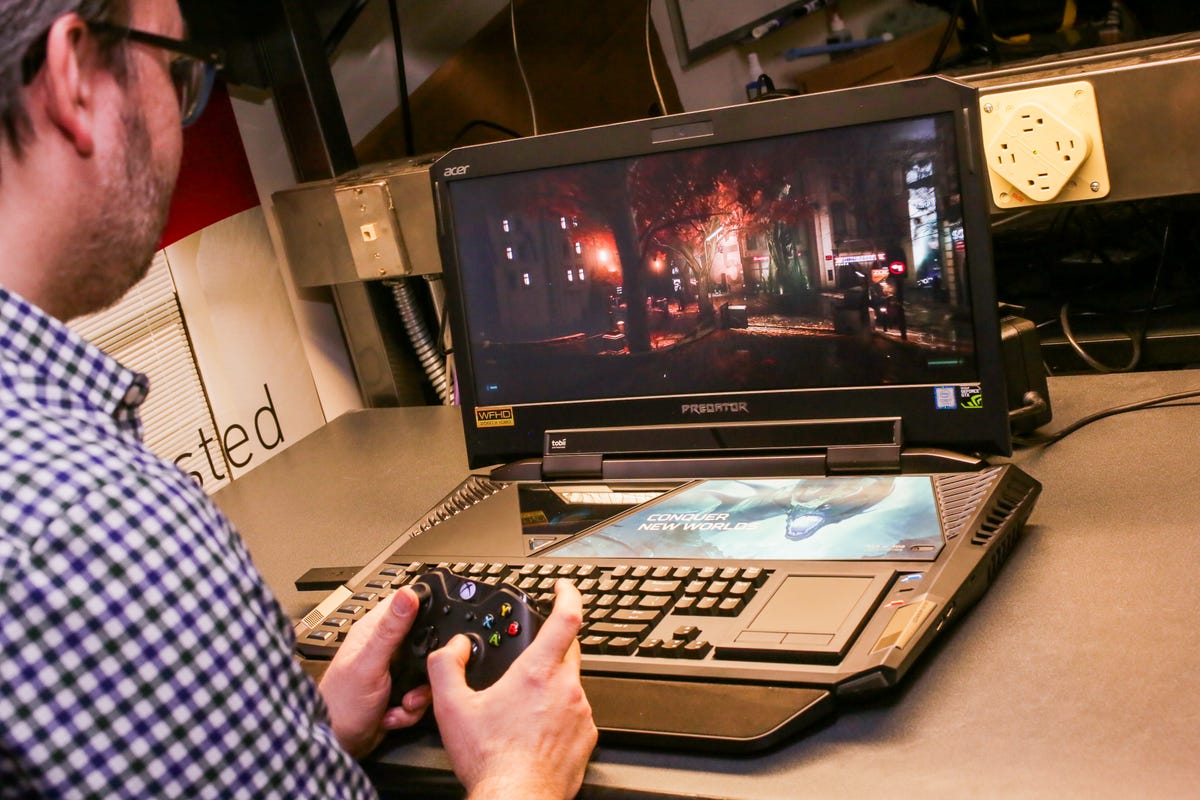
The curved screen adds a level of immersion to games.
I liked how the curved screen added immersion to another new game, the creepy underwater adventure Narcosis. You spend much of the time behind a diving helmet when playing the game, which is a good natural match for a curved screen.
Once you’ve got a compatible game set up and running, the combination of overclocked dual Nvidia 1080 GPUs, overclocked Intel Core i7 CPU (both are software overclocked, via Acer’s Predator Sense app) and the G-Sync display make for an incredibly smooth experience. Of course, very few PC games today even need dual cards to run at very high settings, and the fact that this display has a fairly modest resolution helps, too. However, for such an expensive system the performance wasn’t always better — and was in some cases slower — than much less expensive gaming laptops and desktops. This is even after we updated to a new BIOS provided by Acer. (Deux Ex: Mankind Divided gave us unusually low frame rate scores, for example, although other games and 3D apps performed well.)
There’s another gaming feature built into the Predator 21 X — special eye-tracking hardware and software from Tobii. Using a sensor bar underneath the display (the standard webcam is still on top of the display), the system can track your eye movement and translate this into input in games, or just track your gaze across the Windows desktop (as seen in the video above).

The laptop even includes eye-tracking technology… because why not!
I’ve seen Tobii technology in action a few times before, but never felt it really added much to the game experience. In this case, I tried it with Deus Ex: Mankind Divided, one of the modest number of mainstream games with eye-tracking support. In that case, my in-game camera view would sway left and right as I eyed the scene, and with a little practice, I was able to select items from an inventory wheel or chose a specific barrier to hide behind.
Asus, Alienware and MSI also make laptops with Tobii eye tracking built in, if that’s something you’re interested in. But it never felt quite natural to me, and having the in-game camera sway around without any keyboard or gamepad input was visually jarring.
A laptop, or a decent used car
It’s not that the Acer Predator 21 X costs as much as a used car — that’s a familiar enough comparison to make — but that it costs as much as a half-decent used car. The MSI GT83VR, with a similar dual-GPU setup, mechanical keyboard and tons of high-end extras, clocks in at roughly half the cost, and even that was rightly considered to be wildly expensive.
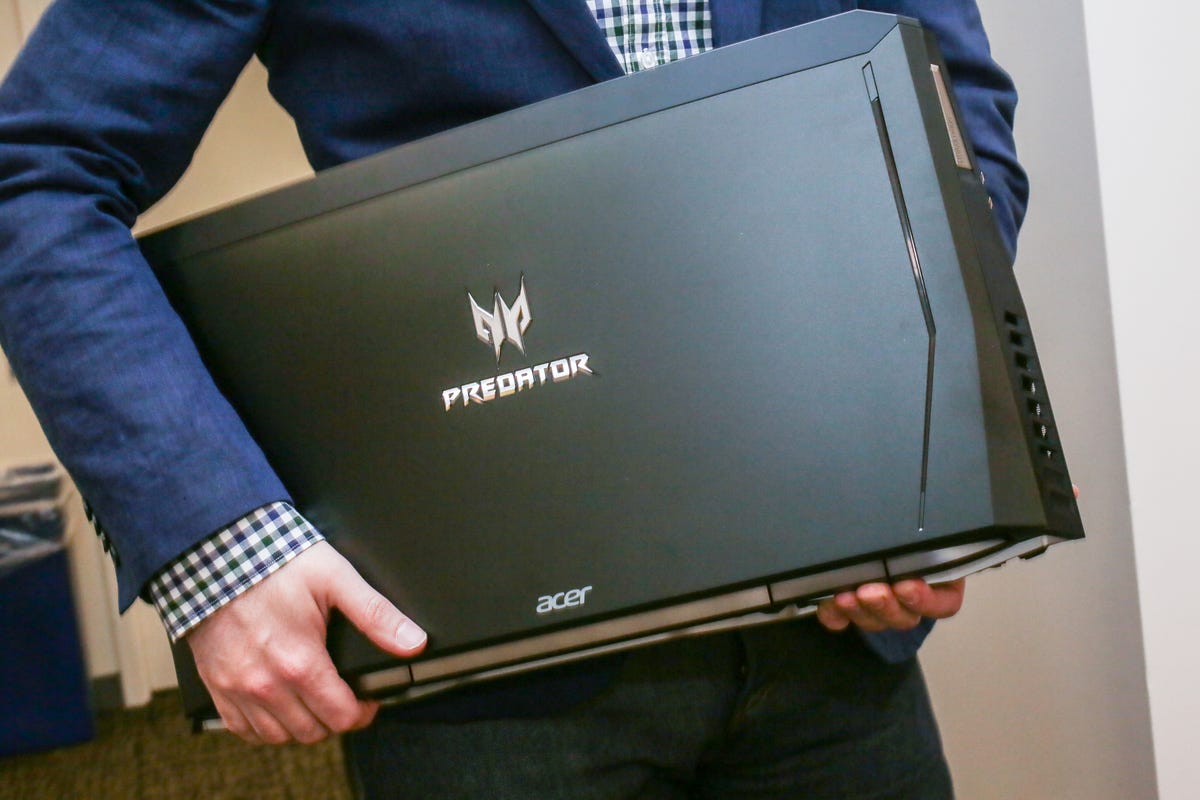
The money spent on this laptop could buy you a decent used car.
But keep in mind what this really is — an experiment in high-end laptop design, with a handful of units (300 in all) available for the public to buy if they feel like investing in a unique conversation starter. Some of the experiments work — I like the mechanical keyboard and curved screen. Some work less well — I could lose the eye tracking and flip-over touchpad.
But playing with the 21 X was one of the most fun experiences I’ve had with a gaming laptop in some time. Hopefully the best ideas from it will work their way down to more affordable gaming laptops, or at least ones that only cost as much as a really old, beat up used car.
Multimedia Multitasking test 3.0
Falcon Northwest Fragbox
81
Origin PC Eon-17X
129
Asus ROG G701V
133
Acer Predator 21 X
139
MSI GT83VR
145
Note: Shorter bars indicate better performance (in seconds)
Geekbench 3 (Multi-Core)
Falcon Northwest Fragbox
39935
Asus ROG G701V
18063
Acer Predator 21 X
17843
Origin PC Eon-17X
17777
MSI GT83VR
14604
Note: Longer bars indicate better performance
Streaming video playback battery drain test
Asus ROG G701V
203
Origin PC Eon-17X
156
MSI GT83VR
123
Acer Predator 21 X
114
Note: Longer bars indicate better performance (in minutes)
3DMark Fire Strike Ultra
Acer Predator 21 X
9444
Falcon Northwest Fragbox
9220
MSI GT83VR
8594
Asus ROG G701V
5226
Origin PC Eon-17X
4970
Note: Longer bars indicate better performance
Bioshock Infinite gaming test
Falcon Northwest Fragbox
276
MSI GT83VR
270
Acer Predator 21 X
251.32
Origin PC Eon-17X
218.65
Asus ROG G701V
209.8
Note: Longer bars indicate better performance (FPS)
Deus Ex: Mankind Divided gaming test
Origin PC Eon-17X
96.4
Asus ROG G701V
93.3
Acer Predator 21 X
68.1
Note: Longer bars indicate better performance (FPS)
System Configurations
Acer Predator 21 X Microsoft Windows 10 Home (64-bit); (oc)2.9GHz Intel Core i7-7820HK; 64GB DDR4 SDRAM 2,400MHz; (oc)(2) 8GB Nvidia GeForce GTX 1080; (2) 512GB SSD RAID 0 + 1TB HDDMSI GT83VR Microsoft Windows 10 Home (64-bit); 2.9GHz Intel Core i7-6920; 32GB DDR4 SDRAM 2,400MHz; (2) 8GB Nvidia GeForce GTX 1080; (2) 512GB SSD RAID 0 + 1TB HDDFalcon Northwest Fragbox Microsoft Windows 10 Home (64-bit); (oc) 4.5GHz Intel Core i7-6950X; 64GB DDR4 SDRAM 2133MHz; (oc) (2) 8GB Nvidia GeForce GTX 1080; 512GB SSD + 6TB HDDOrigin PC Eon-17X Microsoft Windows 10 Home (64-bit); 4.2GHz Intel Core i7-7700K; 16GB DDR4 SDRAM 2,400MHz; 8GB Nvidia GTX 1080; (2) 256GB SSD RAID 0 + 2TB HDDAsus ROG G701V Microsoft Windows 10 Pro (64-bit); 2.9GHz Intel Core i7-7820HK; 64GB DDR4 SDRAM 2,800MHz; 8GB Nvidia GeForce GTX 1080; (2) 512GB SSD RAID 0






